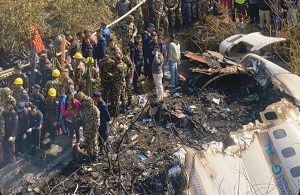Bloomberg
There’s been yet another disaster in one of the world’s deadliest places to fly.
At least 68 people were killed on January 15 after a Yeti Airlines flight crashed when coming in to land in Pokhara, central Nepal, further blighting the country’s notoriously bad aviation safety record. Just last May, 22 people died after a Tara Air flight crashed en route from Pokhara to the trekking base of Jomsom.
Sunday’s was the 11th fatal plane crash in Nepal in as many years, Aviation Safety Network data show. Yeti Airlines was also operating a flight that crashed in 2008 at Lukla’s Tenzing-Hillary Airport, which has a runway that angles down towards a valley and is regarded as one of the world’s most dangerous airports. Eighteen passengers and crew died in that crash. Others include a US-Bangla Airways flight from Dhaka that crashed in Kathmandu in 2018, killing 51 people.
Nepal’s topography and weather patterns make flying harder than in many other places — in 2015, the United Nation’s International Civil Aviation Organisation (ICAO) prioritised the country for technical assistance, later saying its “beautiful but rugged terrain makes the safety of air operations more challenging than in other areas of the world.â€
Sunday’s flight was carrying people from Nepal, India, France, Australia, Ireland, Russia and Korea, according to the Civil Aviation Authority of Nepal. There were 72 people on board the twin-engine ATR-72 turboprop, which took off from Kathmandu at 10:32 am local time and crashed at about 11 am. ATR is a joint venture between planemaking powerhouse Airbus SE and Italy’s Leonardo SpA.
Pilots may have lost control of the plane, causing the disaster, Neil Hansford, chairman of consultancy firm Strategic
Aviation Solutions, told the Australia Broadcasting Corp. Mountains, rough terrain and mists that descend in Nepal are hostile to flying, he said.
As many as 20 Nepalese airlines are prohibited from flying to Europe.
 The Gulf Time Newspaper One of the finest business newspapers in the UAE brought to you by our professional writers and editors.
The Gulf Time Newspaper One of the finest business newspapers in the UAE brought to you by our professional writers and editors.
